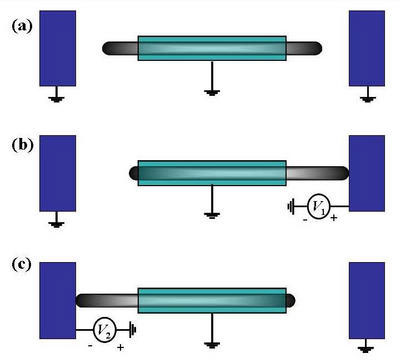| Posted: February 12, 2007 |
Nanotechnology switch design combines the speed of RAM with the stability of a hard drive |
|
(Nanowerk News) University of California Professor Qing Jiang can imagine a computer that boots up immediately on powering up, that writes data directly onto its hard drive making saving a thing of the past.
|
|
In fact, Jiang, a professor of mechanical engineering at the Bourns College of Engineering, is designing the building blocks for this type of memory device using telescoping carbon nanotubes as high-speed, low power microswitches.
|
 |
| General Design of the multi-walled carbon nanotube-based nonvolatile memory device in its neutral position (a); position 1 (b); position 2 (c). (Image: Qing Jiang/UC Riverside)
|
|
The design would allow the use of these binary or three-stage switches to become part of molecular-scale computers. Jiang and co-author Jeong Won Kang have published an article outlining this design online in January by the Institute of Physics. The article will come out in print in the March 7 edition of the journal Nanotechnology ("Electrostatically telescoping nanotube nonvolatile memory device").
|
|
Deceptively simple, the design involves inserting one hollow nanotube, closed at both ends, into a slightly larger one, open at both ends, creating a telescoping motion using an electrostatic charge. That contact between the nanotube and the electrodes creates a conduction pathway with three possible positions.
|
|
The authors suggest that future research should focus on carefully selecting the right material for the electrodes and addressing the phenomenon of rebounding by the nanotube actuator on the electrode.
|
|
The advantages that nanostructures such as quantum dots, carbon nanotubes and nanowires offer over their silicon-based predecessors include their tiny size, speed and their density, according to Jiang.
|
|
“One of the biggest problems for the current non-volatile memories (such as flash memory) is their low speeds,” Jiang said. “We have demonstrated the speed of these devices using simulations switching times of around 10-11 seconds and data erasing times of around 10-12 seconds.”
|
|
The potential of such molecular-scale processors have attracted the attention of major corporations such as Hewlett-Packard, IBM, Lucent, Motorola, Siemens and Hitachi to name a few. Jiang predicted a likely functioning prototype of a molecular processor could be demonstrated in the next two to three years.
|

